Introduction
As organizations increasingly pivot towards cloud-based solutions, the process of cloud migration emerges as a pivotal strategy in the digital transformation journey. This transition involves not only the technical transfer of data and applications but also a comprehensive evaluation of security, compliance, and operational continuity.
With a significant portion of enterprises projected to adopt cloud services in the coming years, understanding the nuances of various migration strategies becomes essential. From the straightforward "lift and shift" approach to more complex refactoring methods, each strategy offers distinct advantages and challenges.
Furthermore, the benefits of cloud migration, such as cost efficiency, scalability, and enhanced collaboration, underscore its necessity in today’s competitive landscape. However, organizations must also navigate potential hurdles, including data security and compliance issues, to ensure a successful transition.
This article delves into the intricacies of cloud migration, providing insights into effective strategies and considerations for organizations embarking on this transformative journey.
Understanding Cloud Migration: An Overview
Cloud transition is the strategic process of transferring data, applications, and other critical business elements from on-premises infrastructure to a cloud migration services company that offers cloud-based services. This transition can encompass various models of computing services, including public, private, and hybrid systems. As organizations increasingly acknowledge the benefits of online services—evidenced by the fact that a significant percentage of enterprises are projected to adopt these solutions by 2024—understanding the complexities of transitioning becomes essential.
This process, executed by a cloud migration services company, involves not only the technical execution of transferring data but also critical considerations surrounding security, compliance, and operational continuity. Organizations must meticulously assess their current IT landscape to identify components appropriate for transition, ensuring that the selected cloud migration services company aligns with their overarching business objectives. Current trends indicate that AWS continues to dominate the market, accounting for 32% of global spending in Q3 2022, while Alibaba Cloud secured a 4% market share in 2023, highlighting the competitive landscape.
As such, Lionel Sujay Vailshery, a research expert focusing on computing technology, emphasizes the significance of strategic planning in transitioning: 'Get in touch with us now.' Moreover, AWS's growth, demonstrated by its expansion to over 200 services and the introduction of its initial 16 'Local Zones' in the US, emphasizes the strategic importance of digital services in improving operational efficiency and scalability. A thorough assessment and planning phase is essential for a successful transition, which a cloud migration services company can provide, setting the stage for improved service delivery and performance.
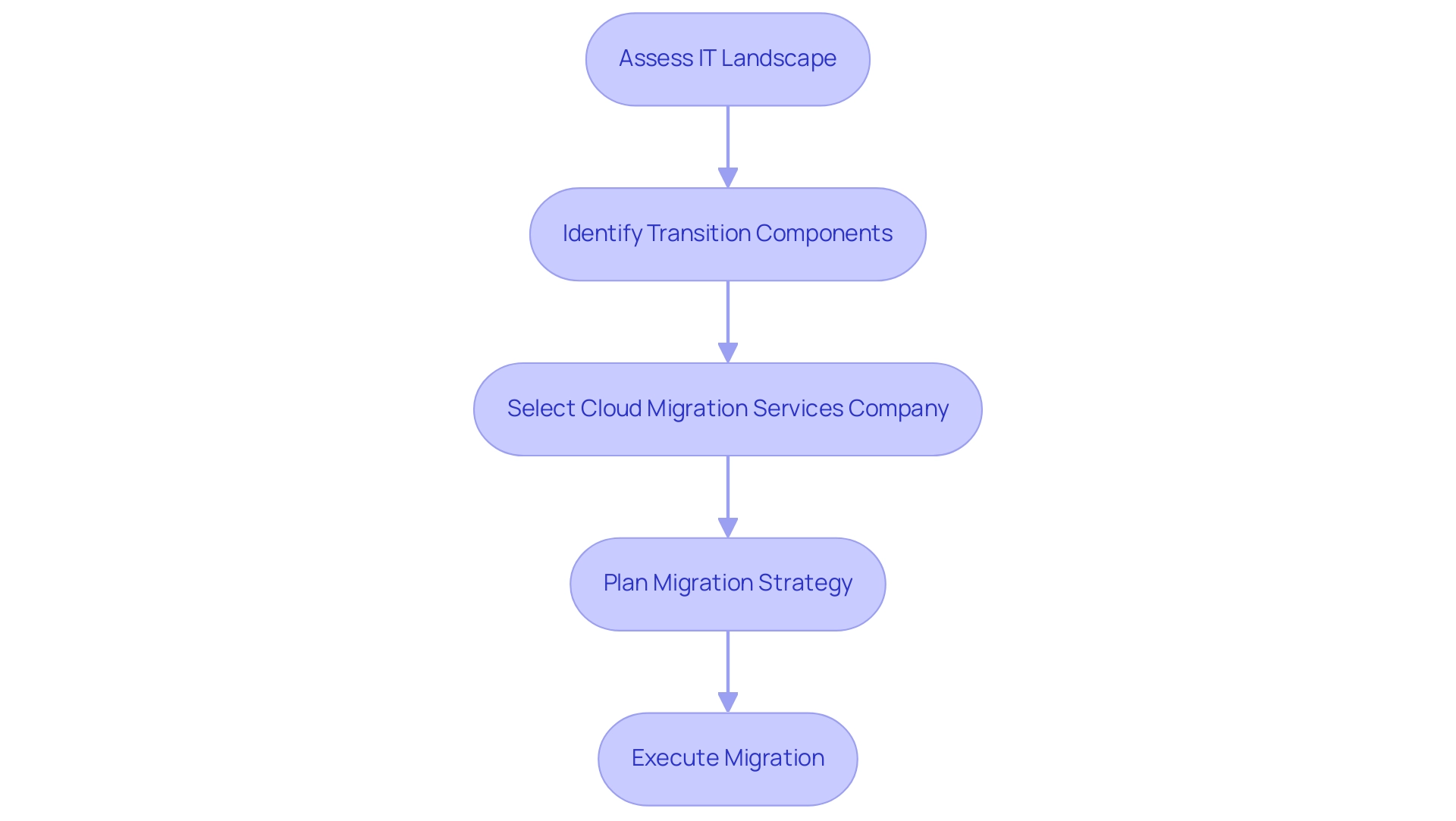
Exploring Different Types of Cloud Migration Strategies
Organizations examining online transition have several strategic choices to evaluate, each with its own benefits and obstacles:
-
Lift and Shift: This technique emphasizes moving applications and information to the remote server with minimal changes, making it one of the quickest transfer strategies. However, while it permits swift deployment, it may not fully utilize the unique advantages of computing. Recent information shows that half of the surveyed companies chose to transition to online services mainly for disaster recovery, highlighting the practical benefits of this approach. As Veeam highlights, 'The online storage plays a vital part in today’s data protection strategy,' underscoring the importance of this method for entities prioritizing data recovery.
-
Re-platforming: This strategy entails implementing specific enhancements throughout the transfer process, allowing organizations to leverage online functionalities while minimizing operational disruption. This approach strikes a balance between speed and efficiency, ensuring that businesses can enhance their applications without extensive downtime.
-
Refactoring: Refactoring is a more comprehensive transition strategy that involves redesigning applications specifically for a virtual environment. Though this method requires more time and resources, it can provide significant long-term advantages by ensuring applications are fully optimized for performance.
-
Hybrid Transition: A hybrid transition approach enables businesses to shift certain applications to the online environment while keeping others on-site. This flexibility can enable a gradual shift to online services, accommodating the unique needs of different applications and business processes.
As the computing services market is expected to attain $864 billion by 2025, it is vital for lasting success to adopt the appropriate migration strategy offered by a cloud migration services company. Furthermore, with the U.S. and Western Europe representing 82% of the global computing services market, businesses must consider regional trends in service adoption to guide their migration strategies. The competitive landscape is illustrated by major providers such as Amazon Web Services, which holds a 31% market share, followed by Microsoft Azure at 25% and Google Cloud at 10%. Comprehending these dynamics is crucial for entities traversing their digital journey.
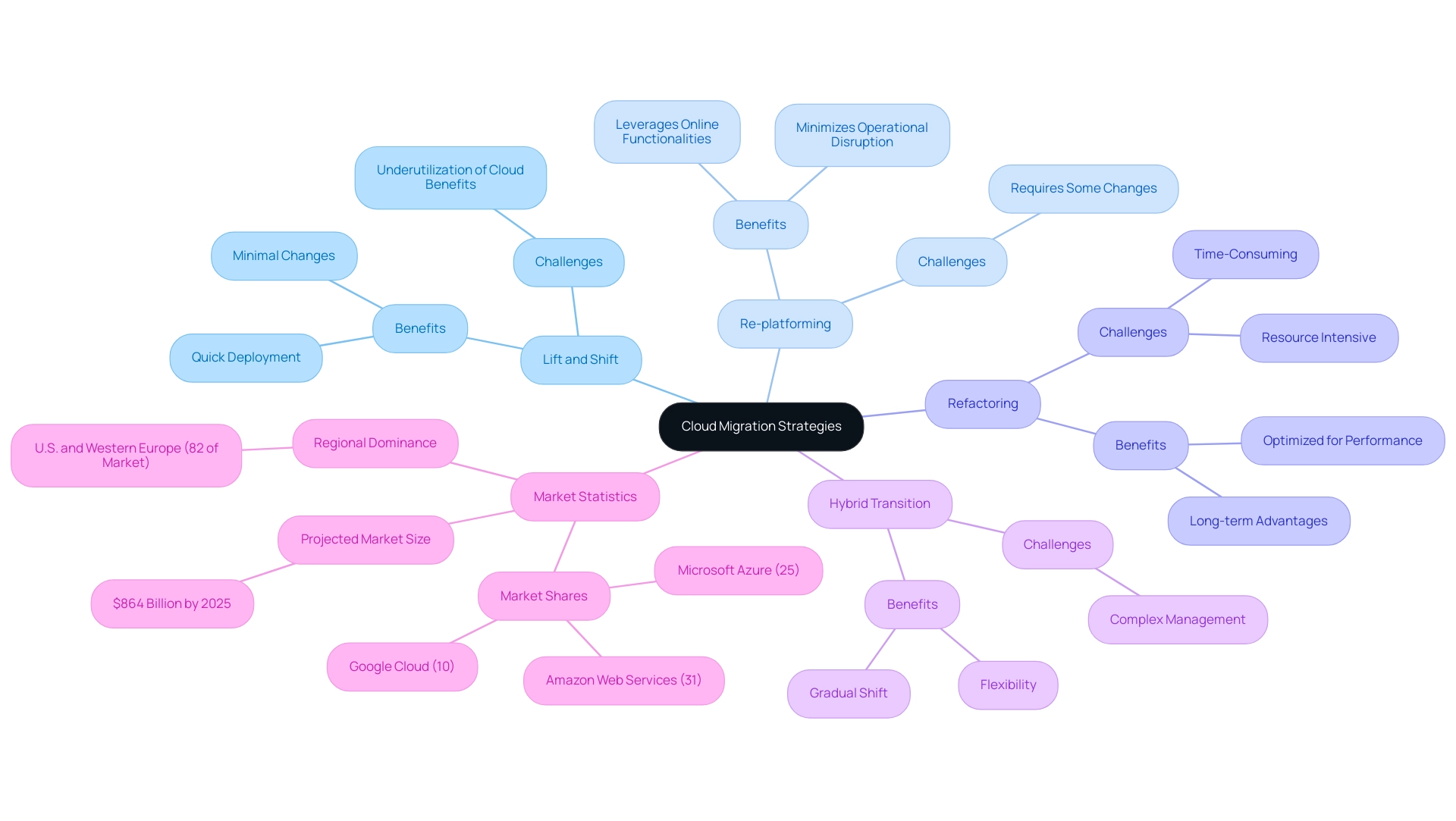
Benefits of Migrating to the Cloud
Transitioning to online services with the help of a cloud migration services company offers companies a variety of benefits that are crucial for sustaining a competitive advantage in today's digital environment. Key benefits include:
-
Cost Efficiency: Moving to a remote environment significantly reduces the reliance on extensive on-premises hardware, leading to lower capital expenditures. Recent studies suggest that entities accomplishing digital transition with the help of a cloud migration services company can realize significant cost reductions, rendering it an appealing choice for budget-minded leaders.
-
Scalability: The cloud migration services company enables businesses to easily adjust resources in reaction to changing demand within a virtual environment. This flexibility is vital for growing enterprises, allowing them to respond swiftly to market changes by utilizing a cloud migration services company without incurring unnecessary costs. Expert views emphasize that this scalability is a vital factor in the adoption of services from a cloud migration services company, with Google Cloud’s Infrastructure as a Service (IaaS) offering experiencing remarkable growth of 63.7%. This growth emphasizes the rising dependence on scalable solutions in the virtual environment, further supporting the migration strategy for entities aiming to succeed in a dynamic market with the help of a cloud migration services company.
-
Enhanced Collaboration: A cloud migration services company helps promote better teamwork among groups by allowing access to information and applications from any location. This accessibility is instrumental in supporting remote work and enhancing productivity across various departments, especially when facilitated by a cloud migration services company.
-
Improved Security: Many cloud migration services companies implement advanced security measures that may be challenging to replicate in-house. As entities prioritize data protection, utilizing the knowledge of a cloud migration services company can significantly enhance their overall security stance.
-
Disaster Recovery: A cloud migration services company typically provides strong backup and recovery options in digital solutions, ensuring business continuity in the event of data loss. This capability not only protects vital information but also fosters trust among stakeholders concerning the operational resilience of a cloud migration services company.
With 98% of U.S. organizations utilizing online services for at least some business operations, Chief Technology Officers must understand the advantages offered by a cloud migration services company. This widespread adoption indicates an urgent need for CTOs to understand the benefits of working with a cloud migration services company to move to a virtual environment. Furthermore, as emphasized in recent reports, the necessity for enhanced communication from service providers regarding AI integration plans is crucial, especially as 56% of IT decision-makers express uncertainty about these strategies offered by a cloud migration services company.
By tackling this communication gap, a cloud migration services company can better align its offerings with the requirements of businesses, ensuring that CTOs can make informed choices regarding their transition strategies. As this atmospheric formation continues to shape the future of business operations, partnering with a cloud migration services company is essential for embracing its advantages and achieving long-term success.
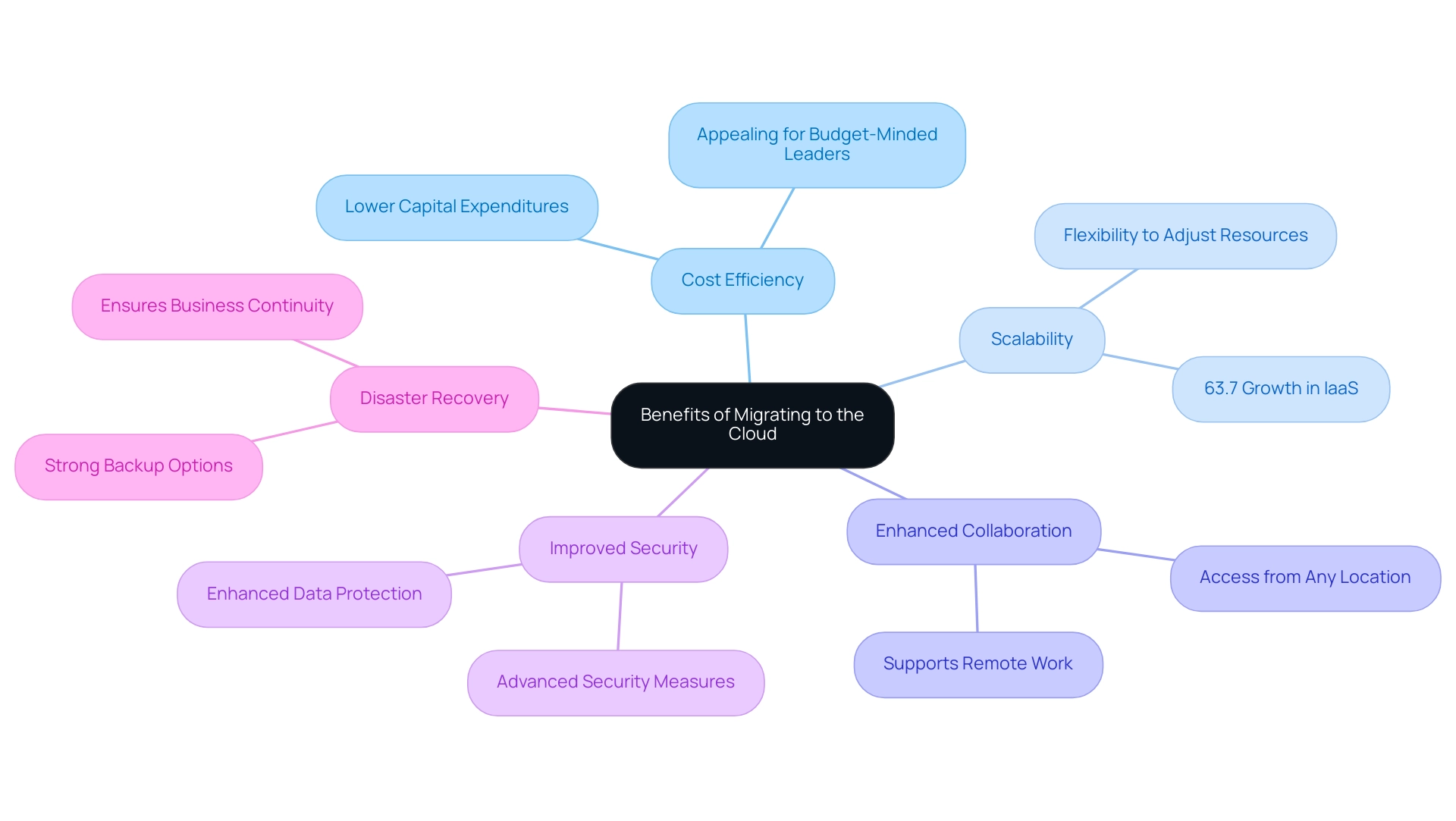
Navigating the Challenges of Cloud Migration
Cloud transfer presents a series of challenges that a cloud migration services company must address to ensure a smooth transition. Among the most pressing issues is Data Security. Protecting information during and after migration is essential; therefore, enterprises are encouraged to adopt strong security measures and collaborate with a cloud migration services company.
Before making effective online security decisions, it is essential for companies to assess their security stance and budget. According to recent data, the world is projected to store a staggering 200 zettabytes of data by 2025, emphasizing the need for stringent security measures to protect sensitive information. Additionally, Compliance poses another significant hurdle.
Organizations must fully understand industry regulations and standards, as failing to comply can lead to severe legal repercussions and operational setbacks. This need for compliance is emphasized by the fact that 98% of U.S. organizations have adopted online services for various business operations, reflecting a trend that necessitates adherence to regulatory requirements.
Integration issues also arise as a critical challenge during the transition. Organizations often face compatibility issues when transferring applications to online platforms, which can disrupt existing systems. To mitigate these risks, thorough testing and meticulous planning are essential before any cloud migration services company commences migration efforts.
Ultimately, Change Management plays a vital role in the successful adoption of technologies offered by a cloud migration services company. Employees may resist the changes brought about by new systems, leading to potential disruptions in operations. Implementing effective change management strategies is essential to foster acceptance among staff and minimize any pushback.
Cody Slingerland observes that together, certain regions represent 82% of the global computing market, highlighting the concentrated nature of this sector and the necessity of tackling these challenges proactively to stay competitive. Furthermore, the growth of Google Cloud's IaaS offering by 63.7% highlights the significance of adapting to these challenges in the evolving market landscape. As companies maneuver through the intricacies of digital transition, identifying and tackling these obstacles will be essential for achieving a successful change.
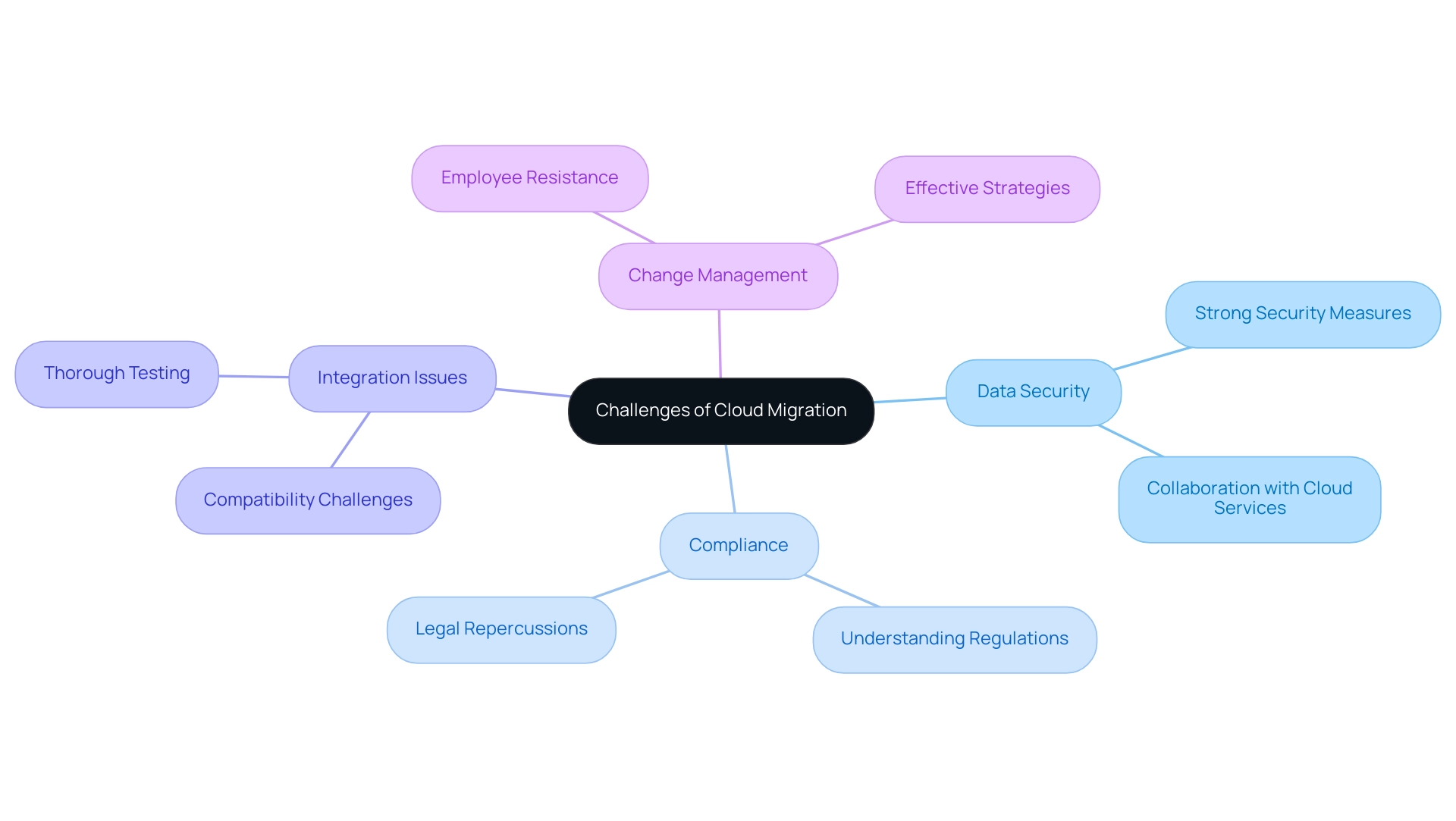
Choosing the Right Cloud Migration Services Company
Choosing the appropriate cloud migration services company is a vital decision that can greatly influence your organization's operational efficiency. Here are the key factors to consider:
-
Experience and Expertise: Prioritize providers that demonstrate a robust track record in cloud transitions, particularly within your industry. Their familiarity with specific challenges and solutions will enhance the transition process. As one client noted, 'STS Consulting Group was the missing piece to my puzzle. From start to finish, the cloud migration services company solved every problem and helped us achieve our goals in the most professional way possible.'
-
Service Offerings: Evaluate if the cloud migration services company provides extensive transfer services, covering everything from initial planning and execution to ongoing post-transfer support. This holistic approach is essential for minimizing disruptions. One client expressed, 'Using STS Consulting Group helped me save weeks of work. Their delightful level of quality and service is consistent and one of a kind.'
-
Security Practices: Data security and regulatory compliance are paramount. Ensure the cloud migration services company has stringent security measures in place to protect your sensitive information throughout the migration.
-
Customer Support: Evaluate the level of customer support available during and after the migration. A responsive support team, bolstered by collaborations with industry leaders—such as Infosys and AWS, Oracle and Microsoft—can facilitate a smoother transition and address any issues that arise promptly. As another client stated, 'I was really impressed with the way STS Consulting Group handled everything. They were very helpful and knowledgeable.'
-
Client References: Request case studies or testimonials from previous clients. For example, organizations such as Drift have successfully optimized their expenses, reducing costs by $2.4 million each year through effective management strategies. Such examples, along with the testimonials provided, can offer insight into a provider's reliability and effectiveness.
As Cody Slingerland notes, 'Combined, these two regions account for 82% of the world’s cloud computing.' Given that the U.S. and Western Europe contribute to this significant market share, selecting a provider with a strong presence and reputation in these regions can enhance your migration experience. By considering these factors, you can make an informed decision that aligns with your organization's strategic objectives.
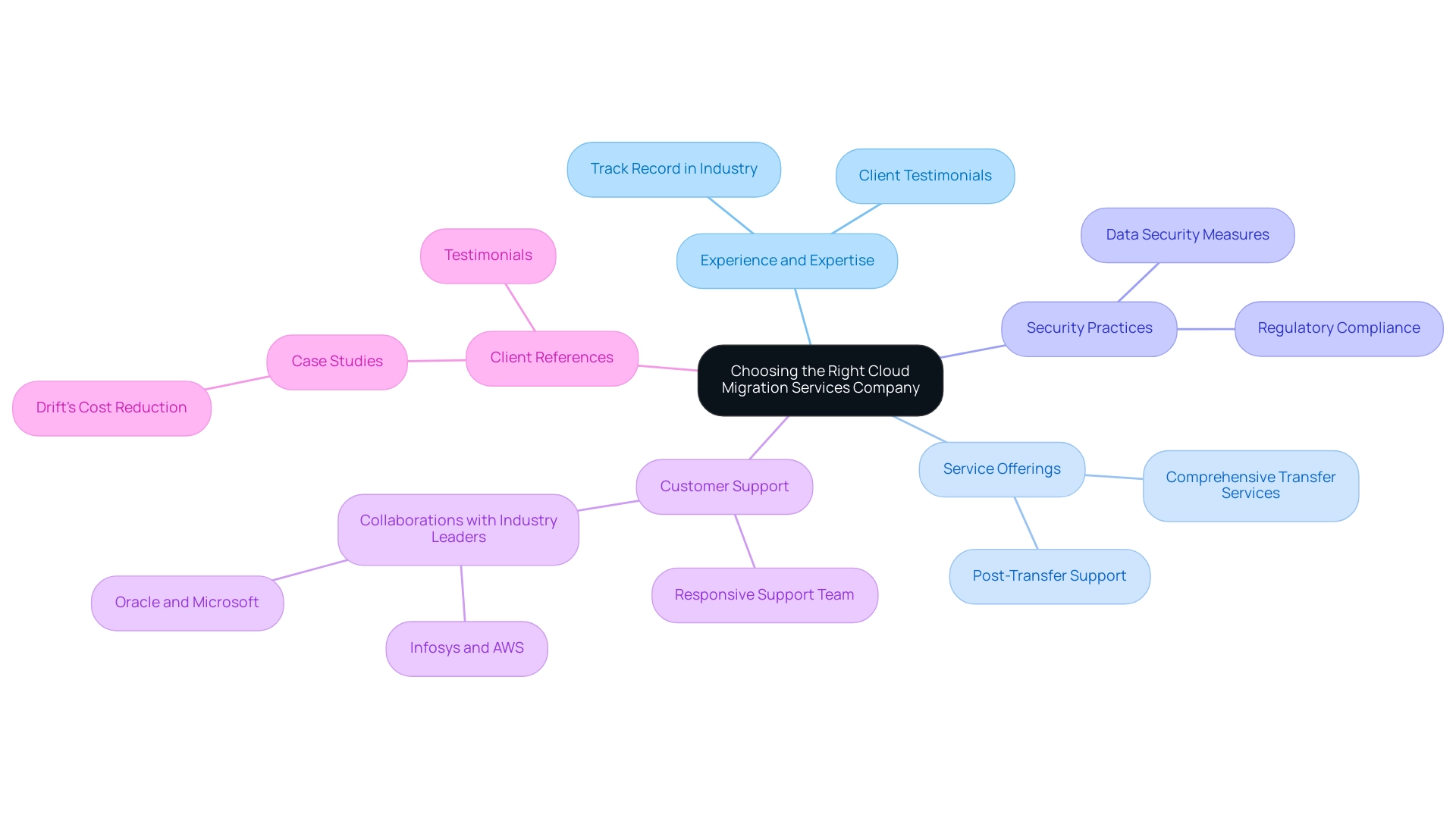
Conclusion
The journey of cloud migration is a multifaceted process that requires careful consideration and strategic planning. From understanding the various migration strategies—such as:
- lift and shift
- re-platforming
- refactoring
- hybrid migration
to recognizing the significant benefits such as:
- cost efficiency
- scalability
- enhanced collaboration
- improved security
organizations must approach this transition with a comprehensive mindset. Each migration strategy presents unique advantages and challenges, necessitating a tailored approach that aligns with specific business goals and operational needs.
While the benefits of migrating to the cloud are substantial, organizations must also navigate critical challenges, including:
- data security
- compliance
- integration issues
- effective change management
Addressing these challenges proactively is essential for ensuring a smooth transition and maximizing the advantages of cloud computing. As the competitive landscape continues to evolve, organizations that prioritize a thorough understanding of these aspects will be better positioned to thrive in the digital era.
Ultimately, selecting the right cloud migration services company plays a pivotal role in the success of this transition. By considering factors such as:
- experience
- service offerings
- security practices
- customer support
- client references
organizations can make informed decisions that align with their strategic objectives. As the cloud continues to shape the future of business operations, embracing its potential is not just beneficial but essential for long-term success and operational resilience.




